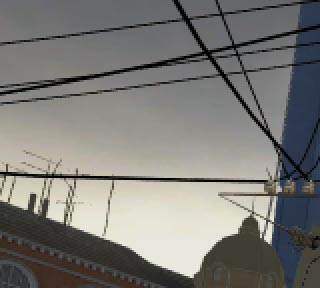NVIDIA's GeForce 8800 (G80): GPUs Re-architected for DirectX 10
by Anand Lal Shimpi & Derek Wilson on November 8, 2006 6:01 PM EST- Posted in
- GPUs
What's Gamma Correct AA?
Gamma correction is a technique used to map linearly increasing brightness data to a display device in a way that conveys linearly increasing intensity. As displays are nonlinear devices, gamma correction requires a nonlinear adjustment to be made to brightness values before being sent to the display. Ideally, gamma corrected linear steps in the brightness of a pixel will result in linear steps in perceived intensity. The application in antialiasing is that high contrast edges can appear under aliased if the brightness of a pixel isn't adjusted high enough for humans to perceive an increase in intensity after being displayed by the monitor.
Unfortunately, gamma correcting AA isn't always desirable. Different CRT, LCD, and TVs have different gamma characteristics that make choosing one gamma correction scheme more or less effective per device. It can also result in brighter colored sub-samples having a heavier influence on the color of a pixel than darker sub-samples. This causes problems for thing like thin lines.
To illustrate the difference, we'll look at images of Half-Life taken on G80 with and without gamma correction enabled.

16XQ No Gamma 16XQ Gamma
Hold mouse over links to see Image Quality

16XQ No Gamma 16XQ Gamma
Hold mouse over links to see Image Quality
We can see the antenna decrease in clarity due to the fact that each of the brighter subsamples has a disproportionately higher weight than the darker subsamples. As far as the roof line is concerned, our options are to see the roof blurring out into the sky, or watching the sky cut into the roof.
Really, edge AA with and without gamma correction is six of one and half a dozen of the other. Combine this with the fact that the effect is different depending on the monitor being used and the degraded visibility of thin lines and we feel that gamma correct AA isn't a feature that improves image quality as much as it just changes it.
While we are happy that NVIDIA has given us the choice to enable or disable gamma correct AA as we see fit, with G80 the default state has changed to enabled. While this doesn't have an impact on performance, we prefer rendering without gamma correct AA enabled and will do so in our performance tests. We hope that ATI will add a feature to disable gamma correct AA in the future as well. For now, let's take a look at R580 and G80 compared with gamma correction enabled.

G80 4X Gamma ATI 4X Gamma
Hold mouse over links to see Image Quality

G80 4X Gamma ATI 4X Gamma
Hold mouse over links to see Image Quality
At 4xAA with gamma correction enabled, it looks like ATI is able to produce a better quality image. Some of the wires and antenna on NVIDIA hardware area a little more ragged looking while ATI's images are smoothed better.










111 Comments
View All Comments
JarredWalton - Wednesday, November 8, 2006 - link
The text is basically complete, and minor spelling issues aren't going to change the results. Obviously, proofing 29 pages of article content is going to take some time. We felt our readers would be a lot more interested in getting the content now rather than waiting even longer for me to proof everything. I know the vast majority of readers don't bother to comment on spelling and grammar issues, but my post was to avoid the comments section turning into a bunch of short posts complaining about errors that will be corrected shortly. :)Iger - Wednesday, November 8, 2006 - link
Pff, of course we would! If I would like to read a novel I would find a book! Results first - proofing later... if ever :) Thanks for the article!JarredWalton - Wednesday, November 8, 2006 - link
Did I say an hour? Okay, how about I just post here when I'm done reading/editing? :)JarredWalton - Wednesday, November 8, 2006 - link
Okay, I'm done proofing/editing. If you still see errors, feel free to complain. Like I said, though, try to keep them in this thread.--Jarred
LuxFestinus - Thursday, November 9, 2006 - link
Pg. 3 under <b>Unified Shaders</b>Should read as follows:
<i>Until now, building a GPU with unified shaders would not have <b>been</b> desirable, let alone practical, but Shader Model 4.0 lends itself well to this approach.</i>
Good try though.;)
shabby - Wednesday, November 8, 2006 - link
$600 for the gtx and $450 for the gts is pretty good seeing how much they crammed into the gpu, makes you wonder why the previous gen topped 650 bucks at times.dcalfine - Wednesday, November 8, 2006 - link
How does the 8800GTX compare to the 7950GX2? Not just in FPS, but also in performance/watt?dcalfine - Wednesday, November 8, 2006 - link
Ignore ^^^sorry
Hot card by the way!
neogodless - Wednesday, November 8, 2006 - link
I know you touched on this, but I assume that DirectX 10 is still not available for your testing platform, Windows XP Professional SP2, and additionally no games have been released for that platform. Is this correct? If so...Will DirectX 10 be made available for Windows XP?
Will you publish a new review once Vista, DirectX 10 and the new games are available?
Can we peak into the future at all now?
JarredWalton - Wednesday, November 8, 2006 - link
DX10 will be Vista only according to Microsoft. What that means according to some game developers is that DX10 support is going to be somewhat slow, and it's also going to be a major headache because for the next 3-4 years they will pretty much be required to have a DX9 rendering solution along with DX10.